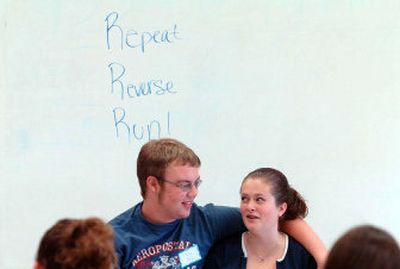Students embrace teaching abstinence

To these kids, it’s cool to wait until adulthood to have sex.
And they want to help spread the abstinence ethic.
About three dozen students at Post Falls High School spent the morning Friday learning how to mentor younger students through the Peers Encouraging Abstinent Kids program.
After being trained, they’ll fan out to middle school health classes to teach one class a week for six weeks on the reasons and ways to avoid having sex.
Jess Grenda was a seventh-grader when she had PEAK peers come to her health classes.
“I was like, Wow. PEAK opened up a lot of doors,” said Grenda, now a senior. “I thought, I can be just like them.”
After this year, Grenda calculates she’ll have taught 240 middle school students how to respect themselves and their partners, and how to avoid being sexually active.
Sam Ryan, also a senior, is in her first year as a PEAK mentor. “It’s something kids should learn,” she said. “The pregnancy rate has gone down since this started.”
PEAK began nine years ago in the Boundary County School District and has since spread to the entire state. It’s financed partially by federal abstinence-only education dollars.
According to the Idaho Governor’s Council on Adolescent Pregnancy Prevention, nearly 40 out of every 1,000 Idaho girls from ages 15 to 17 got pregnant in 1994. In 2003, that number had dropped to just under 30 out of 1,000 girls in that age group.
The decline in teen pregnancy is a nationwide phenomenon, although sexual activity among teenagers remains relatively high. Forty-five percent of high school girls and 48 percent of high school boys have had sexual intercourse, according to a recent report in Pediatrics, the journal of the American Academy of Pediatrics.
Planned Parenthood attributes the drop in pregnancy rates not only to abstinence-only programs, but also to better access to information about contraception.
It cites a study by the Alan Guttmacher Institute that found that between 1988 and 1995, three-quarters of the decline in teen pregnancy was due to improved contraceptive use among sexually active teenagers and one quarter was due to increased abstinence.
That’s supported by a recent report in Pediatrics that states that most successful programs take a varied approach to the problem.
“Our message is always abstinence is the only way you can be 100 percent sure, but if you are making the choice to be sexually active, they need to know how to protect themselves,” said Jet Tilley, spokeswoman for Planned Parenthood of the Inland Northwest.
While PEAK takes an abstinence-only approach, teens at Post Falls High also learn about contraception in health class, health teacher Mel Westlake said.
“We don’t want them to be sexually active,” he said. “But we give them information they need if they choose to be.”
More STDs
While pregnancy rates are dropping, the number of teenagers getting sexually transmitted infections is on the rise.
Every day, about 8,000 teenagers are getting infected nationwide, according to the state’s Adolescent Pregnancy Prevention program. An increase in the practice of oral sex among teens, including students in middle school, may be part of the problem, Shelley Rambo Robertson of Adolescent Pregnancy Prevention told school nurses at a recent convention in Coeur d’Alene.
“Girls will choose oral sex over vaginal because that way they’ll still be a virgin,” she said.
Chlamydia, which increased 33 percent in Idaho from 1999 to 2003 and is the fastest growing sexually transmitted infection, can be spread orally. It can lead to infertility if untreated.
A report released in September by the National Center for Health Statistics shows that slightly more than half of U.S. teenagers between 15 and 19 have engaged in oral sex, and 70 percent of all 18- and 19-year-olds have.
Students in Westlake’s high school health class are treated to a graphic slide show from the Panhandle Health District on sexually transmitted infections, he said.
“We pull no punches,” he said.
Planned Parenthood’s sex education curriculum for teens teaches that the most common symptom of a sexually transmitted infection is no symptom, said Margaret Mount, education director for Planned Parenthood of the Inland Northwest. She teaches that anyone who is sexually active should get tested for infections.
Kids involved in the PEAK program talk some about sexually transmitted diseases, but not in great detail. They talk about it primarily as one of several good reasons not to have sex.
“Can anyone tell me what STD stands for?” Grenda asked during a practice presentation Friday morning. Her classmates piped up in unison, “sexually transmitted disease.”
“Who wants to walk around with an STD the rest of your life?” she asked.